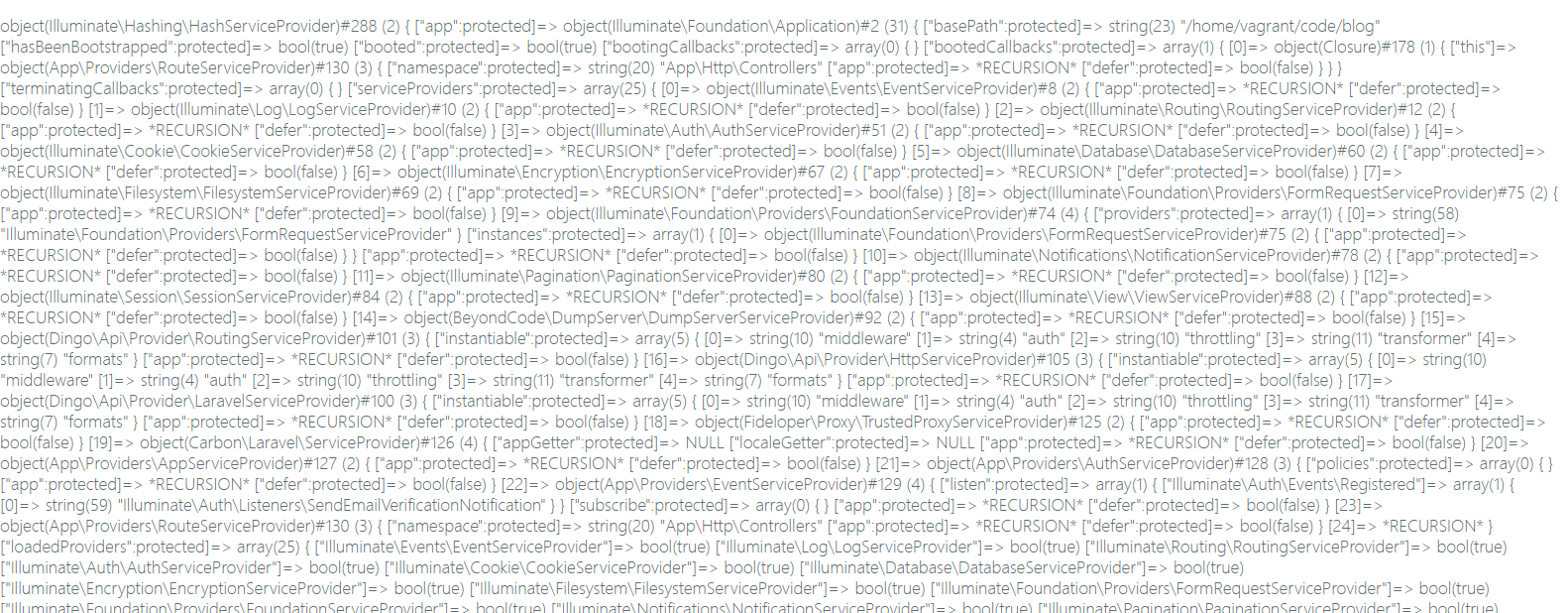第六章:继续前行
约 3314 字大约 11 分钟
2025-07-08
我们继续分析第四章中提到的四个主要动作中的第三个动作:注册服务提供者,
设置基础目录路径注册基础绑定注册服务提供者
注册核心别名类
对应的是下面这行代码:
$this->registerBaseServiceProviders();追踪这个方法的具体实现:
/**
* Register all of the base service providers.
*
* @return void
*/
protected function registerBaseServiceProviders()
{
$this->register(new EventServiceProvider($this));
$this->register(new LogServiceProvider($this));
$this->register(new RoutingServiceProvider($this));
}vendor/laravel/framework/src/Illuminate/Foundation/Application.php
继续追踪register:
/**
* Register a service provider with the application.
*
* @param \Illuminate\Support\ServiceProvider|string $provider
* @param bool $force
* @return \Illuminate\Support\ServiceProvider
*/
public function register($provider, $force = false)
{
if (($registered = $this->getProvider($provider)) && ! $force) {
return $registered;
}
// If the given "provider" is a string, we will resolve it, passing in the
// application instance automatically for the developer. This is simply
// a more convenient way of specifying your service provider classes.
if (is_string($provider)) {
$provider = $this->resolveProvider($provider);
}
$provider->register();
// If there are bindings / singletons set as properties on the provider we
// will spin through them and register them with the application, which
// serves as a convenience layer while registering a lot of bindings.
if (property_exists($provider, 'bindings')) {
foreach ($provider->bindings as $key => $value) {
$this->bind($key, $value);
}
}
if (property_exists($provider, 'singletons')) {
foreach ($provider->singletons as $key => $value) {
$this->singleton($key, $value);
}
}
$this->markAsRegistered($provider);
// If the application has already booted, we will call this boot method on
// the provider class so it has an opportunity to do its boot logic and
// will be ready for any usage by this developer's application logic.
if ($this->isBooted()) {
$this->bootProvider($provider);
}
return $provider;
}vendor/laravel/framework/src/Illuminate/Foundation/Application.php
要通读这个方法的所有代码,请参考【附录六】。在这一章中,我们关注的核心代码是下面这句:
$provider->register();即register方法的主要动作,就是执行provider对象本身的register方法,然后就返回对象实例本身了。于是我们继续追踪provider对象身上的register方法。由于provider对象指向哪个实例是不确定(由传入的参数决定)的,因此我们以第一个EventServiceProvider为例,进入这个类中,继续去追踪它的register方法:
/**
* Register the service provider.
*
* @return void
*/
public function register()
{
$this->app->singleton('events', function ($app) {
return (new Dispatcher($app))->setQueueResolver(function () use ($app) {
return $app->make(QueueFactoryContract::class);
});
});
}vendor/laravel/framework/src/Illuminate/Events/EventServiceProvider.php
我们看到,register方法,执行了一次singleton,singleton方法我们在第五章中已经讲解过,它的主要作用就是往app这个共享的容器身上挂载键值对。这里,我们看到events这个"键"再次被挂载到一个闭包值上了。
除此之外,我们还要重点关注一下,实例化provider的过程中,provider类的构造函数执行了什么,我们发现构造函数在父类\Illuminate\Support\ServiceProvider中:
/**
* Create a new service provider instance.
*
* @param \Illuminate\Contracts\Foundation\Application $app
* @return void
*/
public function __construct($app)
{
$this->app = $app;
}vendor/laravel/framework/src/Illuminate/Support/ServiceProvider.php
我们看到,这里只是简单地将传入的app变量值赋值给类的成员变量app。查看每个provider的register方法,你会发现,它们都是使用$this->app->singleton...这种方式去实现具体的register动作。我们看到,不管框架在"注册基础服务提供者"这个步骤中执行了多少次register,最后这些注册的服务类,都会被容器app"接收",将来也是通过调用app去进行具体的实现。
此外,还值得注意的是,我们发现了下面这段代码:
if ($this->isBooted()) {
$this->bootProvider($provider);
}大家可以通过"var_dump中断测试"(参考【附录一】)来测试一下,在默认情况下,注册第一个EventServiceProvider时,$this->isBooted()这里返回值是false。
也就是说,最开始register的时候,并没有走到这个if里面去。然而在if里面加exit语句,刷新应用主页时,代码却能成功进入到if中去。
如下,我们进行两次var_dump中断测试:
第一次:
var_dump($provider);
var_dump($this->isBooted());
exit;
if ($this->isBooted()) {
$this->bootProvider($provider);
}输出结果:

【图6.1】
第二次:
if ($this->isBooted()) {
var_dump($provider);exit('ccc');
$this->bootProvider($provider);
}输出结果:

【图6.2】
由于输出的字符串太长,我们仅截取部分显示在这里。
很明显,register方法至少被执行了两次:一次是应用启动时,一次是应用启动后。而且我们发现了一个比较奇怪的现象:第二次var_dump中断测试时页面要加载较长时间才能运行完成(对比第一次有明显的延时)。这是什么原因造成的呢?
要了解事情的真相,还得从var_dump打印的内容开始入手,按照我们的猜想,应用启动后,输出一个provider对象信息后,程序马上就退出(exit)了,没有道理有这么明显的延时。
现在我们来仔细查看var_dump语句输出的内容:
object(Illuminate\Hashing\HashServiceProvider)#288 (2) {
["app":protected]=>
object(Illuminate\Foundation\Application)#2 (31) {
["basePath":protected]=>
string(23) "/home/vagrant/code/blog"
["hasBeenBootstrapped":protected]=>
bool(true)
["booted":protected]=>
bool(true)
["bootingCallbacks":protected]=>
array(0) {
}
["bootedCallbacks":protected]=>
array(1) {
[0]=>
object(Closure)#178 (1) {
["this"]=>
object(App\Providers\RouteServiceProvider)#130 (3) {
["namespace":protected]=>
string(20) "App\Http\Controllers"
["app":protected]=>
*RECURSION*
["defer":protected]=>
bool(false)
}
}
}
["terminatingCallbacks":protected]=>
array(0) {
}
["serviceProviders":protected]=>
array(25) {
[0]=>
object(Illuminate\Events\EventServiceProvider)#8 (2) {
["app":protected]=>
*RECURSION*
["defer":protected]=>
bool(false)
}
[1]=>
object(Illuminate\Log\LogServiceProvider)#10 (2) {
["app":protected]=>
*RECURSION*
["defer":protected]=>
bool(false)
}
[2]=>
...
... ...我们看到,HashServiceProvider对象里面包含app保护成员,这个保护成员正好就是全局唯一的容器对象,并且在很多其他地方我们都看到了:*RECURSION*。这是因为每一个ServiceProvider类型的对象都会将app这个容器放到自己的app保护成员变量上,这实际上造成了多次的递归引用。
这里的"ServiceProvider类型"的对象,是指所有服务提供者类的实例,这些服务提供者类有一个共同的特征,就是都继承了
\Illuminate\Support\ServiceProvider类。
从app容器这个对象的内容来看,我们发现在应用启动后,app包含了很多provider类型的对象。通过查看isBooted方法的源码,我们能梳理出app的保护成员变量booted是什么时候从false变成true的。在phpstorm IDE中全局搜索"->booted",我们能看到,正是在boot方法之后,booted值被赋值为了true:
/**
* Boot the application's service providers.
*
* @return void
*/
public function boot()
{
if ($this->isBooted()) {
return;
}
// Once the application has booted we will also fire some "booted" callbacks
// for any listeners that need to do work after this initial booting gets
// finished. This is useful when ordering the boot-up processes we run.
$this->fireAppCallbacks($this->bootingCallbacks);
array_walk($this->serviceProviders, function ($p) {
$this->bootProvider($p);
});
$this->booted = true;
$this->fireAppCallbacks($this->bootedCallbacks);
}vendor/laravel/framework/src/Illuminate/Foundation/Application.php
上面的代码显示:应用启动后,会逐个去运行每个ServiceProvider类型对象的bootProvider方法。
这样我们就明白了:在应用启动之前,app容器已经"接收"完了所有的ServiceProvider类型对象,而每个ServiceProvider类型对象的保护成员app又都指向了容器本身,这必然造成大量的递归引用。所以这时候打印一个provider对象的信息就不是那么容易的事情。这里我们可以简单分析一下:程序先调用语句创建出一个对象A,对象A调用语句创建出对象B,同时把A本身注入到B中去,这时代码中一共包含了3个对象的信息:A,A.B, A.B.A(最后这个A.B.A就是递归引用了)。继续调用语句创建出对象C,情况变成了:A, A.B, A.C, A.B.A, A.C.A。即此时变成了5个对象,其中包含两个递归引用。即我们每多注册一个ServiceProvider,对象数量就增加2,并且多一个递归引用。而在我们的配置文件config/app.php文件中定义了多个需要注册的providers:
'providers' => [
/*
* Laravel Framework Service Providers...
*/
Illuminate\Auth\AuthServiceProvider::class,
Illuminate\Broadcasting\BroadcastServiceProvider::class,
Illuminate\Bus\BusServiceProvider::class,
Illuminate\Cache\CacheServiceProvider::class,
Illuminate\Foundation\Providers\ConsoleSupportServiceProvider::class,
Illuminate\Cookie\CookieServiceProvider::class,
Illuminate\Database\DatabaseServiceProvider::class,
Illuminate\Encryption\EncryptionServiceProvider::class,
Illuminate\Filesystem\FilesystemServiceProvider::class,
Illuminate\Foundation\Providers\FoundationServiceProvider::class,
Illuminate\Hashing\HashServiceProvider::class,
Illuminate\Mail\MailServiceProvider::class,
Illuminate\Notifications\NotificationServiceProvider::class,
Illuminate\Pagination\PaginationServiceProvider::class,
Illuminate\Pipeline\PipelineServiceProvider::class,
Illuminate\Queue\QueueServiceProvider::class,
Illuminate\Redis\RedisServiceProvider::class,
Illuminate\Auth\Passwords\PasswordResetServiceProvider::class,
Illuminate\Session\SessionServiceProvider::class,
Illuminate\Translation\TranslationServiceProvider::class,
Illuminate\Validation\ValidationServiceProvider::class,
Illuminate\View\ViewServiceProvider::class,
/*
* Package Service Providers...
*/
/*
* Application Service Providers...
*/
App\Providers\AppServiceProvider::class,
App\Providers\AuthServiceProvider::class,
// App\Providers\BroadcastServiceProvider::class,
App\Providers\EventServiceProvider::class,
App\Providers\RouteServiceProvider::class,
],当然还需要加上系统默认注册的3个ServiceProvider类型的类,才是总的需要注册的Providers数。
通过前面var_dump的输出,我们能发现除了ServiceProvider类型类的注册会造成递归引用外,容器其他的一些成员变量(保存回调事件的成员)保存的闭包中,也包含了递归引用。因此,即使是打印一个对象的信息,也可能造成浏览器内存溢出,导致最后打印失败。
读者可能会问这样一个问题,为什么Laravel在不中断的情况输出首页又没有这么明显的延时呢?
答案很简单:var_dump打印某个对象的信息很慢,但是执行对象上的方法却可以很快。就像"我们去拆解一辆汽车的所有零部件,将这些零部件的信息完整呈现出来需要耗费大量时间,但是点火启动汽车却可能不到1秒"一样。
接下来,我们分析最后一个动作:注册核心别名类。
设置基础目录路径注册基础绑定注册服务提供者注册核心别名类
对应的是下面这行代码:
$this->registerCoreContainerAliases();继续追踪registerCoreContainerAliases方法:
/**
* Register the core class aliases in the container.
*
* @return void
*/
public function registerCoreContainerAliases()
{
foreach ([
'app' => [self::class, \Illuminate\Contracts\Container\Container::class, \Illuminate\Contracts\Foundation\Application::class, \Psr\Container\ContainerInterface::class],
'auth' => [\Illuminate\Auth\AuthManager::class, \Illuminate\Contracts\Auth\Factory::class],
'auth.driver' => [\Illuminate\Contracts\Auth\Guard::class],
'blade.compiler' => [\Illuminate\View\Compilers\BladeCompiler::class],
'cache' => [\Illuminate\Cache\CacheManager::class, \Illuminate\Contracts\Cache\Factory::class],
'cache.store' => [\Illuminate\Cache\Repository::class, \Illuminate\Contracts\Cache\Repository::class],
'config' => [\Illuminate\Config\Repository::class, \Illuminate\Contracts\Config\Repository::class],
'cookie' => [\Illuminate\Cookie\CookieJar::class, \Illuminate\Contracts\Cookie\Factory::class, \Illuminate\Contracts\Cookie\QueueingFactory::class],
'encrypter' => [\Illuminate\Encryption\Encrypter::class, \Illuminate\Contracts\Encryption\Encrypter::class],
'db' => [\Illuminate\Database\DatabaseManager::class],
'db.connection' => [\Illuminate\Database\Connection::class, \Illuminate\Database\ConnectionInterface::class],
'events' => [\Illuminate\Events\Dispatcher::class, \Illuminate\Contracts\Events\Dispatcher::class],
'files' => [\Illuminate\Filesystem\Filesystem::class],
'filesystem' => [\Illuminate\Filesystem\FilesystemManager::class, \Illuminate\Contracts\Filesystem\Factory::class],
'filesystem.disk' => [\Illuminate\Contracts\Filesystem\Filesystem::class],
'filesystem.cloud' => [\Illuminate\Contracts\Filesystem\Cloud::class],
'hash' => [\Illuminate\Hashing\HashManager::class],
'hash.driver' => [\Illuminate\Contracts\Hashing\Hasher::class],
'translator' => [\Illuminate\Translation\Translator::class, \Illuminate\Contracts\Translation\Translator::class],
'log' => [\Illuminate\Log\LogManager::class, \Psr\Log\LoggerInterface::class],
'mailer' => [\Illuminate\Mail\Mailer::class, \Illuminate\Contracts\Mail\Mailer::class, \Illuminate\Contracts\Mail\MailQueue::class],
'auth.password' => [\Illuminate\Auth\Passwords\PasswordBrokerManager::class, \Illuminate\Contracts\Auth\PasswordBrokerFactory::class],
'auth.password.broker' => [\Illuminate\Auth\Passwords\PasswordBroker::class, \Illuminate\Contracts\Auth\PasswordBroker::class],
'queue' => [\Illuminate\Queue\QueueManager::class, \Illuminate\Contracts\Queue\Factory::class, \Illuminate\Contracts\Queue\Monitor::class],
'queue.connection' => [\Illuminate\Contracts\Queue\Queue::class],
'queue.failer' => [\Illuminate\Queue\Failed\FailedJobProviderInterface::class],
'redirect' => [\Illuminate\Routing\Redirector::class],
'redis' => [\Illuminate\Redis\RedisManager::class, \Illuminate\Contracts\Redis\Factory::class],
'request' => [\Illuminate\Http\Request::class, \Symfony\Component\HttpFoundation\Request::class],
'router' => [\Illuminate\Routing\Router::class, \Illuminate\Contracts\Routing\Registrar::class, \Illuminate\Contracts\Routing\BindingRegistrar::class],
'session' => [\Illuminate\Session\SessionManager::class],
'session.store' => [\Illuminate\Session\Store::class, \Illuminate\Contracts\Session\Session::class],
'url' => [\Illuminate\Routing\UrlGenerator::class, \Illuminate\Contracts\Routing\UrlGenerator::class],
'validator' => [\Illuminate\Validation\Factory::class, \Illuminate\Contracts\Validation\Factory::class],
'view' => [\Illuminate\View\Factory::class, \Illuminate\Contracts\View\Factory::class],
] as $key => $aliases) {
foreach ($aliases as $alias) {
$this->alias($key, $alias);
}
}
}vendor/laravel/framework/src/Illuminate/Foundation/Application.php
这个方法的代码相对来说,是比较容易理解的,相当于是双重foreach循环。第一层循环,从数组中抽出单个的$key和$aliases。第二层循环,因为$aliases可能是多维数组,因此继续遍历$aliases数组,将其中的单个值和之前的$key组合为参数,传递给$alias方法。
我们重点关注一下alias方法:
/**
* Alias a type to a different name.
*
* @param string $abstract
* @param string $alias
* @return void
*
* @throws \LogicException
*/
public function alias($abstract, $alias)
{
if ($alias === $abstract) {
throw new LogicException("[{$abstract}] is aliased to itself.");
}
$this->aliases[$alias] = $abstract;
$this->abstractAliases[$abstract][] = $alias;
}vendor/laravel/framework/src/Illuminate/Foundation/Application.php
这里面的逻辑也很简单,就是对当前对象的aliases和abstractAliases成员变量进行赋值。
至此,我们终于讲完了【艰难的开始】这一章中说的全部四个步骤:
设置基础目录路径注册基础绑定注册服务提供者注册核心别名类
现在,让我们重新回到app.php文件源码:
<?php
/*
|--------------------------------------------------------------------------
| Create The Application
|--------------------------------------------------------------------------
|
| The first thing we will do is create a new Laravel application instance
| which serves as the "glue" for all the components of Laravel, and is
| the IoC container for the system binding all of the various parts.
|
*/
$app = new Illuminate\Foundation\Application(
$_ENV['APP_BASE_PATH'] ?? dirname(__DIR__)
);
/*
|--------------------------------------------------------------------------
| Bind Important Interfaces
|--------------------------------------------------------------------------
|
| Next, we need to bind some important interfaces into the container so
| we will be able to resolve them when needed. The kernels serve the
| incoming requests to this application from both the web and CLI.
|
*/
$app->singleton(
Illuminate\Contracts\Http\Kernel::class,
App\Http\Kernel::class
);
$app->singleton(
Illuminate\Contracts\Console\Kernel::class,
App\Console\Kernel::class
);
$app->singleton(
Illuminate\Contracts\Debug\ExceptionHandler::class,
App\Exceptions\Handler::class
);
/*
|--------------------------------------------------------------------------
| Return The Application
|--------------------------------------------------------------------------
|
| This script returns the application instance. The instance is given to
| the calling script so we can separate the building of the instances
| from the actual running of the application and sending responses.
|
*/
return $app;bootstrap/app.php
可以看到,剩下的三行代码,都是采用singleton方法,给app容器"绑定"相关的类。
singleton方法我们在第五章中已经讲解过,此处不再赘述
这里,我们简单看一下绑定的这几个类的作用:
- App\Http\Kernel类是处理HTTP请求的,大家可以通过阅读源码看到,这个Kernel类不仅包含处理http请求参数的方法,还内置了"嵌入容器对象","嵌入路由类",处理中间件,执行Laravel核心路由解析等等全部核心过程
- App\Console\Kernel类是处理命令行环境下php执行相关动作的
- App\Exceptions\Handler类是处理异常相关的
至此,我们终于讲完了第二章中的"第二阶段"。